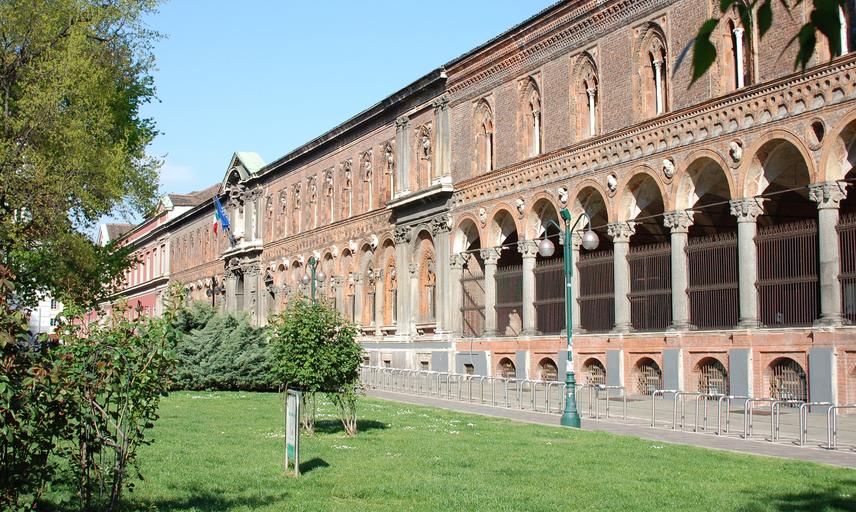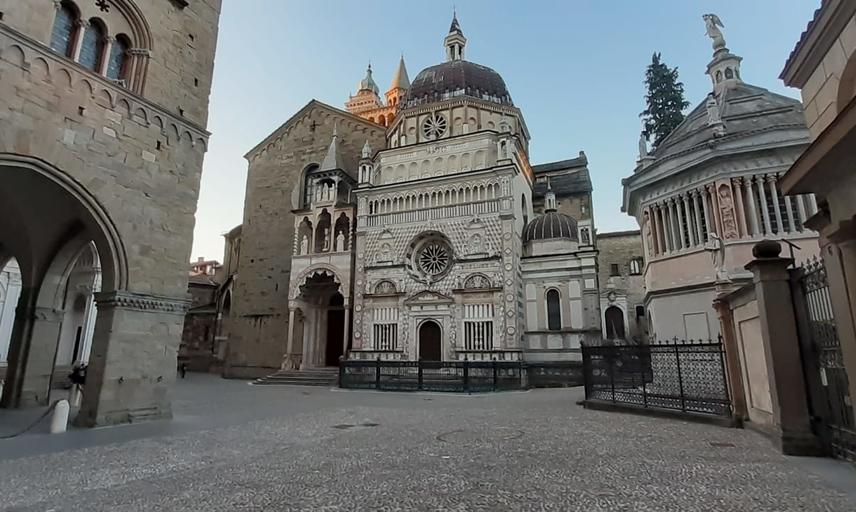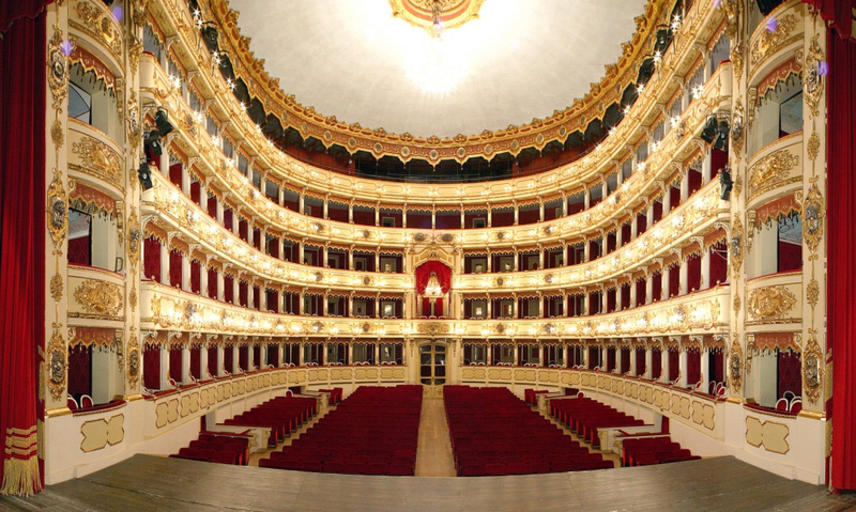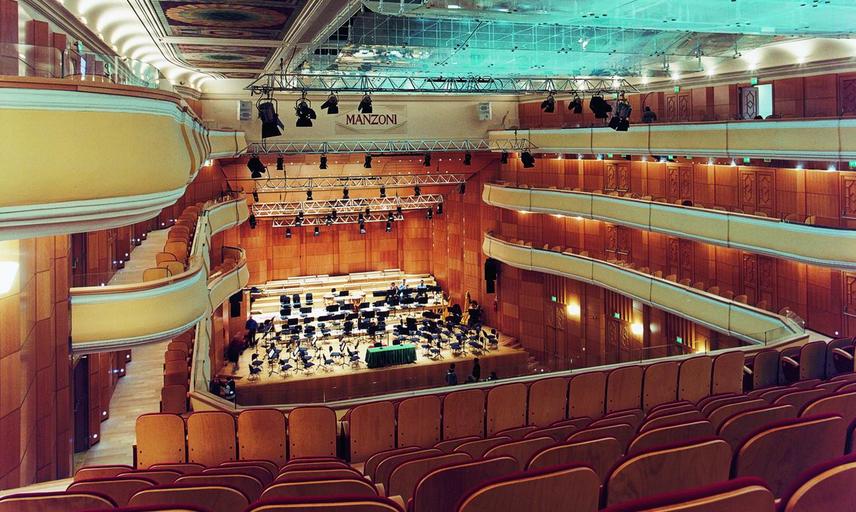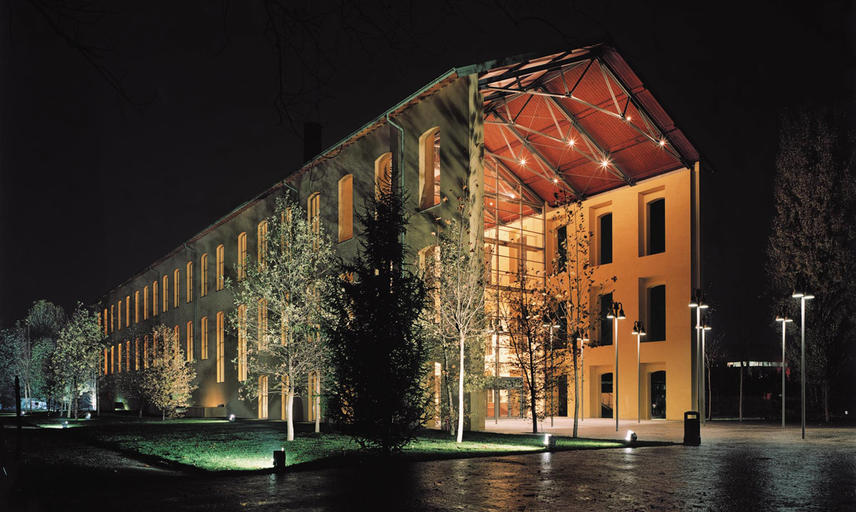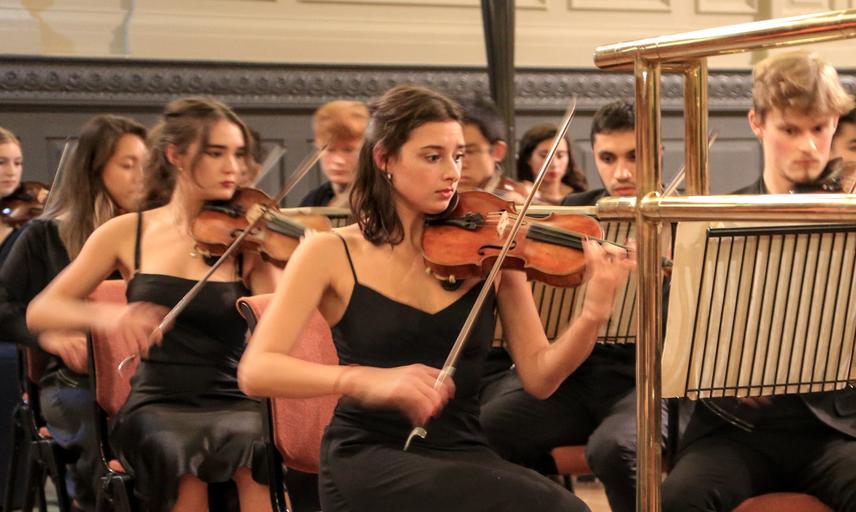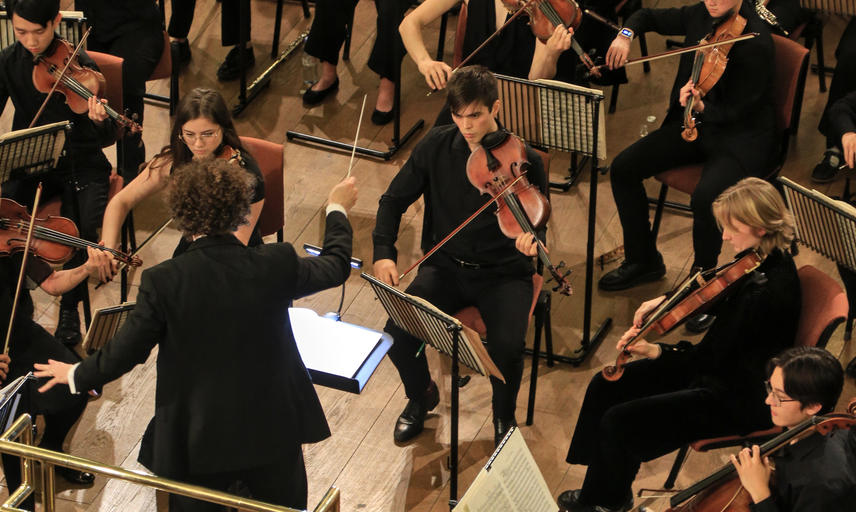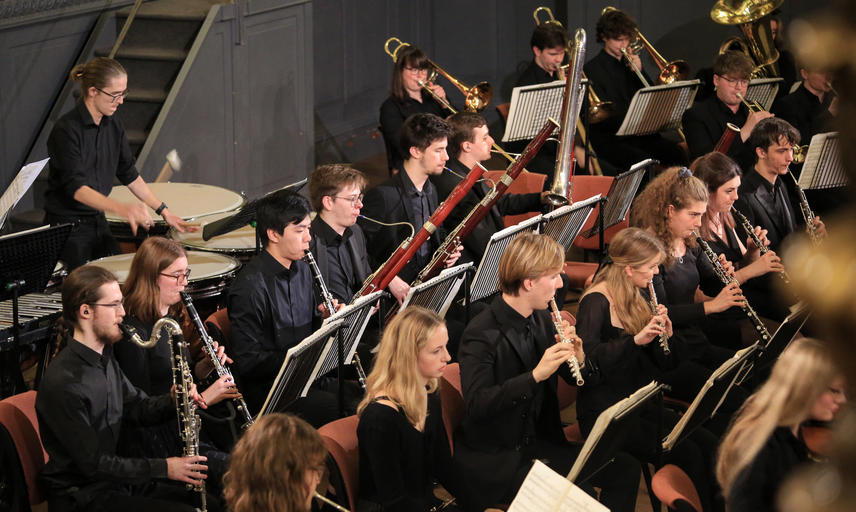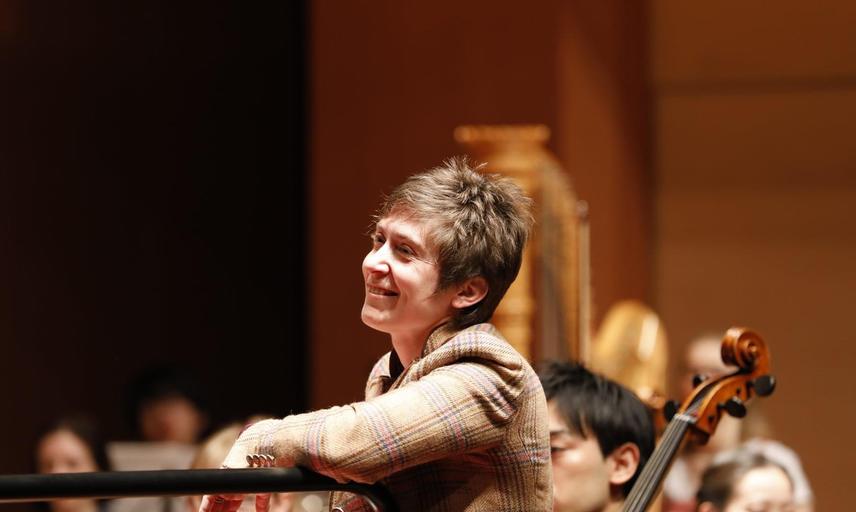Northern Italy Tour, March 2024
English | Italiano
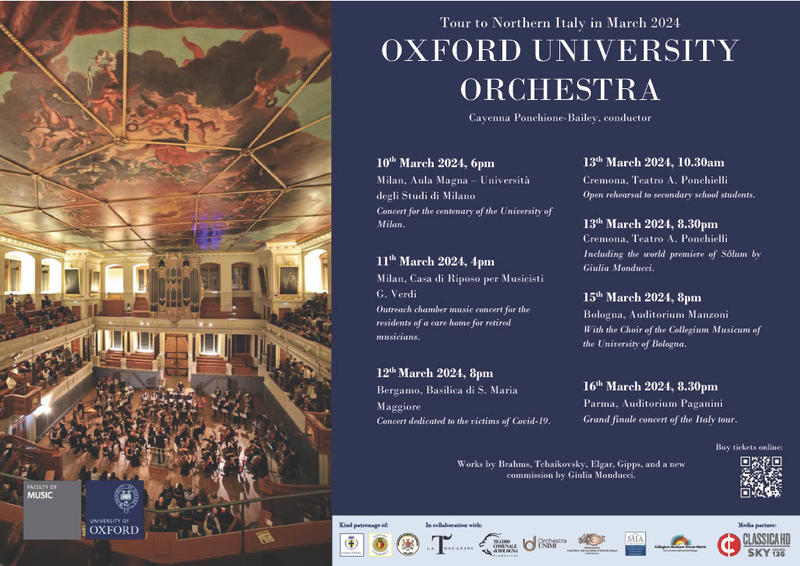
The Oxford University Orchestra's Great Success in Italy, March 2024
OUO, alongside conductor Cayenna Ponchione-Bailey thrilled Italian audiences during our tour. The programme, from Sunday 10th to Saturday 16th March 2024 through the cities of Milan, Bergamo, Cermona, Bologna, and Parma included five orchestral concerts (one in collaboration with the choir of the University of Bologna), a rehearsal open to school students, and a chamber music concert in a care home.

As Oxford University’s premier ensemble, OUO is made up of talented students reading a range of subjects from Music to Maths, to Chemistry and History. Since 1958 we have had a reputation for tackling some of the most challenging parts of the orchestral repertoire in Oxford concerts, including old favourites and championing equally brilliant lesser-known works. For the second time in its history (the first was Japan in 2019), the orchestra embarked on a tour abroad. This time, the chosen destination was northern Italy (Lombardy and Emilia-Romagna).
During the week-long tour, the 62-piece orchestra performed the beautiful melodies of Brahms’ Second Symphony, Tchaikovsky’s Romeo and Juliet (a tribute to Shakespeare and the city of Verona) and Ruth Gipps’ exceptional Second Symphony, never performed in Italy before this tour. The orchestra also presented the world premiere of Sŏlum, a new composition by Italian composer and Oxford alumna Giulia Monducci, commissioned specifically for the tour on the theme of environmental sustainability. The piece, inspired by the works of Indian scientist and activist Vandana Shiva, was well received for its “dissonances that amaze the listener, envelop them and weave around them an unexpectedly reassuring plot full of emotional suggestion” (La Provincia di Cremona). Of great success also the collaboration with the Choir of the Collegium Musicum Almae Matris of the University of Bologna, with which the orchestra tackled Edward Elgar’s From the Bavarian Highlands.
On top of the busy concert itinerary, the tour was also an opportunity for the orchestra (many of whom had never been to these places or even Italy) to discover the beauties of this country. There was no shortage of opportunities to explore monuments and taste the food and wine delicacies of the area. In Cremona, the visit to the Violin Museum was splendid, while in Parma the orchestra was welcomed for a private visit to the Teatro Regio. Harpist Isabel Samuel (Medicine, New College) tells us that “one of the most beautiful moments was climbing to the top of the Duomo of Milan and seeing the spires turn pink at sunset”.
Bergamo
Cremona
Bologna
Parma
The Programme
Sponsors and Partners
Supporting Us
Giulia Monducci, Sŏlum
Cayenna Ponchione-Bailey
Milan
Sunday 10th March, Aula Magna, University of Milan

The concert itinerary began in Milan, where the orchestra performed to a sold-out Aula Magna, guest of Orchestra UNIMI’s concert season dedicated to the centenary celebrations of the University of Milan, one of the largest generalist institutions in Italy. The concert was well received for the “compactness of the ensemble which maintains transparency in the orchestral writing” (OperaClick).
The itinerary continued with selected chamber ensembles (a wind quintet, a flute quartet, and a string octet) who perform for the residents of the Casa di Riposo per Musicisti G. Verdi, the historic Milanese care home for retired musicians and opera singers founded by the great Italian opera composer (who is buried there) in 1896. The performances were warmly received by the audience and the performers were then offered a guided visit of the magnificent, neo-Gothic building designed by Camillo Boito. Bassoonist Conrad Spencer (Music, Jesus College) tells us: "Playing at the care home was a rewarding and enriching experience – not only did we get to perform to a receptive and appreciative audience, but the opportunity of visiting a place so steeped in history was a great honour."
From OperaClick, Luca Fialdini:
The Oxford University Orchestra last toured in 2019; after five years the orchestra resumes its international appearances with the Italy Tour 2024, seven events in northern Italy, the first of which is hosted by the University of Milan . In this project, the orchestra is conducted by Cayenna Ponchione-Bailey , with whom it has a long collaboration (e.g., the 2019 Japanese tour); particular is the choice of the program which, despite being normal for a professional team, is anything but negligible in difficulty for a university musical organisation, albeit a high-level one.
The first proposal is Tchaikovsky's beloved Romeo and Juliet fantasy overture , which allows us to appreciate some qualities of the orchestra, from the rather beautiful color to the enthusiasm of the performers. There are some perfectible features, for example the incorrect entries of the flutes in the stringendo immediately before the Allegro correct (the duel with the swords), the general intonation of the strings has some occasional oscillations and the timpani curiously omit the F# in fortissimo two bars before that sort of Totentanz which is the Moderate assai; nevertheless, the performance has many strong points: you can clearly feel the great work done by the orchestra and conductor on the timbres in the chorale of clarinets and bassoons which evokes the figure of Friar Laurence, for example, or even the beautiful control of the pizzicato, which it is also expressive and rich in nuances, the fire that emerges in the most excited moments and the interventions of Isabel Samuel 's harp are a note of merit. For her part, Ponchione-Bailey's direction guarantees the coherence of the whole and is very careful to meet the needs of the orchestra without going beyond its possibilities; The care taken in the final sections of the overture is not to be taken for granted, namely the aforementioned Totentanz – very measured in intensity – and in the symbolic ascent to heaven (which in all probability Tchaikovsky borrowed from the more famous «stairway to Paradise» of the Après une lecture du Dante by Liszt).
Even better was the performance of the demanding Second Symphony by Johannes Brahms, a title that represents an authentic turning point in the composer's catalogue: his first works of some importance with the orchestra had required particular meticulousness from him (the Variations on a Theme by Haydn , first written for two pianos and then patiently orchestrated) or had a really long gestation, as in the case of the Concerto for piano and orchestra no. 1 in D minor which required almost six years of work, or the Symphony no. 1 in C minor which required twenty-one; Symphony No. 2 in D major op. 73 was written in the summer of 1877, immediately after the conclusion of the First, during the holiday periods in Pörtschach.
This sudden birth has left clear signs in the writing, which never evokes the imprint of chaos or disorder, but in its almost classical clarity appears to be imbued with a magmatic energy, a thematic boiling which bears the pen of author to some abrupt changes of direction in the management of the sections and of the codicil succession itself, which can be observed in the almost unjustifiable climax of the last movement which culminates in a clear reminiscence of the finale of Beethoven's Fifth . In this continuous gathering of the form into knots, however, elegance and taste for architecture appear, in fact the entire symphonic system is based on that three-note phrase that appears in the first measure of the first movement, enunciated by cellos and double basses; the various thematic elements that appear throughout the Symphony are clearly audible, including the Wiegenlied (the famous Lullaby) which is expressly mentioned in the first movement. The Oxford University Orchestra invests a lot in the compactness of the ensemble while managing to maintain that entirely Brahmsian transparency of the orchestral writing: it can be seen very well in the incipit of the second movement, characterized by a characteristic independence of the parts, the horn solos well chiseled - dangerously discovered in the symphonic plot - and among the classical scents emerges that sense of mourning that Brahms explains in more than one letter, up to the sensational finale in which the orchestra gives vent to its energies, gathering well-deserved applause.
Bergamo
Tuesday 12th March, Basilica di S. Maria Maggiore

The second symphonic concert took place in the magnificent Basilica di S. Maria Maggiore in Bergamo’s ‘Città Alta’. The orchestra embarked on a day trip to the City of Culture 2023 making its way to the upper town either by funicular or walking up the world-heritage Venetian walls that encircle the medieval town. The concert, a few days ahead of the commemoration week, was dedicated to the victims of Covid-19 which, as the President of the city council pointed out in a greeting at the start of the concert, particularly affected the city of Bergamo. The notes of the Tchaikovsky and Brahms resonated in the place where opera composer Gaetano Donizetti is buried, decorated with wonderful frescoes, and, in the words of cellist Johan Orly (History, Christ Church College), “the most beautiful place I have ever performed in”.
Cremona
Wednesday 13th March, Teatro A. Ponchielli

An intense day in which the orchestra engaged in a double performance at the seventeenth-century Teatro A. Ponchielli in Cremona: an open rehearsal on Tchaikovsky’s Romeo and Juliet to school students in the morning and a concert in the evening.
In the morning, the orchestra performed to an audience of middle and high school students as part of the project ‘Oltre I Banchi’ ('Beyond the Desks'). The young audience demonstrated great enthusiasm and asked many questions to the conductor and the musicians. An aspiring young conductor, Giuseppe, was also invited to the podium.
Our evening concert included two premieres along with Tchaikovsky and Brahms: the first Italian performance of the Second Symphony by Ruth Gipps, an English composer of the 20th century, and the world premiere of a new commission by Giulia Monducci, Italian composer and Oxford alumna on the theme of environmental sustainability and climate change. The performance was warmly received for the passion demonstrated by the young musicians: “the British orchestra showed good resilience as well as enthusiasm and serenity from every pore” (Cremona Sera). In a review by a local high school student, the concert is described as “extraordinary, an experience that made the strings of the soul vibrate and accompanied the audience on a journey through a rich panorama of musical emotions. The programme, masterfully curated, offered an eclectic range of compositions, ranging from contemporary to classical, thus guaranteeing an unforgettable evening for music lovers of all genres and all times” (La Provincia di Cremona). On top of the varied musical programme, performing in such a beautiful theatre was an incredible experience. As flautist Amy Fry (Music, Lincoln College) says, “playing in such a beautiful venue was a surreal and once-in-a-lifetime experience. I feel extremely lucky to have had this opportunity”.
From La Provincia di Cremona, Russo Ludovico Emanuele - V Stradivari Music High School (translated)
The appointment with #DIRITTODICRITICA is back , the initiative organized by the newspaper La Provincia and the Amilcare Ponchielli Theatre Foundation, which offers students from Cremonese schools the opportunity to express their reasoned and reasoned opinion on the shows on the bill at the Ponchielli. The protagonist of this event is the Oxford University Orchestra.
The Oxford University Orchestra concert, held on 13 March 2024 at the Ponchielli Theatre, was extraordinary, an experience that made the strings of the soul vibrate and took the audience on a journey through a rich panorama of musical emotions. The program, expertly curated, offered an eclectic range of compositions, ranging from contemporary to classic, thus guaranteeing an unforgettable evening for fans of music of all genres and of all times. The opening of the concert was entrusted to "Solum" by Giulia Monducci: dissonances that amaze the listener, envelop him and weave around him an unexpectedly reassuring plot full of emotional suggestion. Pëtr Ilyich Tchaikovsky with Overture-Fantasy in B minor from “Romeo and Juliet” for a leap into the past. A masterpiece effectively rendered by the young musicians who were able to give strength to the contrasts between the themes. The deep touch of the clarinets and bassoons, like organ pipes, underline the drama, then in the silence of the latter, the strings insinuate themselves to paint a gothic atmosphere. The performance of Ruth Gipps' "Symphony No. 2 in B Major" was a pleasant discovery: less known, very rich in orchestral colours, it demonstrated the talent of the British composer. The interventions of the percussion section are particularly interesting. To end the evening on a high note, the majestic performance of the “Symphony n. 2 in D Major” by Brahms. The orchestra constantly maintained energy and interpretative tension, under the aegis of a baton, that of Cayenna Ponchione-Bailey, who with precision and determination made every nuance of the score palpable. The flashes of the clarinet and the flights of the wind instruments on the pizzicato strings lead to the conclusion; the themes play on each other until evoking the closing with the sudden return of the initial theme pushed by woodwind and brass. A joyful explosion of music that, despite the flow of time, remains young and permeated with emotions, ideals and values, sometimes contrasting and in conflict with each other, but still immortal.
From Cremona Sera, Loris Braga
The Oxford University Orchestra enthuses Ponchielli on the Cremonese date of the Italian tour. Lots of applause for the great university team considered the best in Europe
An evening dedicated to the symphonic repertoire that was staged at the Ponchielli Theater in this new appointment with the concert season. In the spotlight is the Oxford University Orchestra , one of the best university orchestras in Europe. The program opens with a new composition, world premiere: Sŏlum , commissioned by the Oxford University Orchestra for this tour from Giulia Monducci. A great mix of dissonances has woven a song full of meaning born from a suggestion on the theme of climate change, food and profit.
A step back a little more than a century brings us to the harmonies of Pyotr Il'ič Tchaikovsky with the Overture-Fantasy in B minor from “Romeo and Juliet”. Closing the first part of the concert is a very rarely performed composition in orchestral repertoires: Symphony No. 2 by Ruth Gipps. The British team showed good resistance as well as letting enthusiasm and serenity shine through from every pore. A sensation that was confirmed in the excellent performance of the monumental Symphony No. 2 by Johannes Brahms. Guest conductor Cayenna Ponchione-Bailey held the reins of the large ensemble firmly without "stressing" the instrumentalists but putting them in a position to give their best. And so it was. The wind sections performed well, showing meticulous attention to the articulation of sounds and cleanliness in the attacks. The percussion department is also excellent. Truly excellent level of strings, which wets the noses of many professional orchestras also heard on this same stage, showing a dense, rich sound, sculpted in the most agile passages and full of harmonics in the great legates. There was also a lot of attention paid to the sound levels, making this concert a truly high-level event in the city's concert season. The audience gave generous applause, reciprocated with an encore, the beautiful Intermezzo from Giordano's Fedora. The Oxford University Orchestra is the flagship ensemble of the Oxford University Music Society , which includes 5 classical orchestras. A symphony "A", the one in concert on the Cremonese stage, a counterpart "B", a professional chamber ensemble and two amateur orchestras. Only in Oxford. All of this is jaw-dropping. Suffice it to say that the members of this "first" orchestra are not even all from the Music department. Although selected through rigorous auditions (and it shows), many of the instrumentalists on the staff belong to other departments such as Medicine, History and other humanistic and scientific faculties. A great lesson received from these talented musicians who brought high quality performances to Cremona. A reality that should make us reflect for a long time on our city and shout, like Gene Wilder in the role of Doctor Frederick von Frankenstein in Mel Brooks' film: "It can be done!"
From CremonaOggi, Federica Priori
Vibrant energy on the Ponchielli stage on Wednesday evening in Cremona with the over sixty young artists of the Oxford University Orchestra conducted by Cayenna Ponchione-Bailey, who proposed a varied program alternating classical music by Tchaikovsky and Brahms with contemporary music. The team performed in the city theater as a stop on an Italian tour which is visiting various concert halls and also includes musical projects in collaboration with local cultural entities, as stated by the musical artistic secretary Lorenzo Del Pecchia, underlining Ponchielli's attention towards youth orchestras. The concert opened with the opera Solum by Italian composer and Oxford alumnus Giulia Monducci , commissioned especially for the tour. Applause in the hall for the band, which is the main student orchestra of the University of Oxford and includes students from various subjects ready to perform every term in the seventeenth-century Sheldonian Theatre.
https://www.youtube.com/embed/TxYyWzP7jwM?si=rATef_tLU0yv7HSz
Bologna
Friday 15th March, Auditorium Manzoni

The tour itinerary continued in Bologna where the orchestra, hosted by the Fondazione Teatro Comunale di Bologna, shared the stage and social time with the almost one hundred choristers of the Choir of the Collegium Musicum Almae Matris of the University of Bologna – prepared by Nicola Carli and David Winton – in a performance of From the Bavarian Highlands by Edward Elgar. The almost one thousand spectators in the audience demonstrated great enthusiasm for the students of the two oldest universities in Europe, performing in the magnificent setting of the Teatro Auditorium Manzoni, a former cinema of the 1930s. Even if created in just two days of rehearsals, the strong harmony between the two ensembles made the performance nothing short of electrifying. As horn player Callum Scott (Engineering, Somerville College) says: “it was such an incredible experience and privilege to be able to play alongside a choir with such amazing tone colours. This was made even more special in the Manzoni where we performed, which carried the sound to everyone watching”.
Parma
8.30pm Saturday 16th March, Auditorium Paganini

The grand finale of the tour was in the concert hall designed by renowned architect Renzo Piano – a former sugar-refinery converted in to a beautiful performance venue – in collaboration with La Toscanini. We would like to thank CAPAS (University of Parma) for their support with instruments and equipment. As in all the other concerts, the warm applause was reciprocated by an encore, the famous Intermezzo from Fedora by Umberto Giordano, a small tribute to the rich Italian opera tradition.
The Programme
In Italy, the 62 players of the the orchestra performed Brahms’ beautifully melodic 2nd Symphony, Tchaikovsky’s Romeo and Juliet overture, and Ruth Gipps’ exceptional 2nd Symphony. Alongside these we premiered Sŏlum, a new composition by Italian composer and Oxford graduate Giulia Monducci, commissioned specifically for this tour. We also collaborated with the Choir of the University of Bologna in a performance of Elgar's From the Bavarian Highlands.
Our repertoire was carefully chosen to showcase the rich cultural heritage of Italy and the UK, with an Italian premiere of a symphony by a British composer, Ruth Gipps, and a new commission by an Italian composer, Giulia Monducci, who, as an Oxford graduate, is connected to both regions. In addition, Tchaikovsky's Romeo and Juliet sets to music one of the most renowned Shakespearian dramas, set in the northern Italian city of Verona. As part of the cultural exchange nature of the project, we chose to present a choral piece by Elgar: a piece of English music that we performed alongside almost 100 Italian university singers!
Finally, we immersed ourselves in Italy's rich operatic tradition by performing a beautiful (surprise!) encore that paid tribute to this incredible repertoire. For this, we selected the Intermezzo from Umberto Giordano's opera Fedora.
The musical programme of the tour combined some of the audience's symphonic favourites, yet championing lesser-known and contemporary works to bring a fresh and unique touch to each of our performances.
Sponsors and Supporters

The success of the tour owes much to the support of generous donors and local realities. We would like to thank our media partner Classica HD, who told the story of the orchestra through an interview with Tommaso Rusconi (Music, Jesus College), the new Milanese manager of the orchestra, as part of the programme ‘Mestiere e Teatro’ curated by Paolo Gavazzeni, which was broadcast on Sky. We would also like to thank the sponsors Braida, Ruggeri, Rustichella d’Abruzzo, and Millutensil, as well as the British Chamber of Commerce for Italy (BCCI) and the municipalities of Parma and Bergamo for their patronage.
Finally, we are pleased to have collaborated with our charity partner, the Lega del Filo d'Oro, who were with us in Milan and Parma and gave the opportunity to some deaf-blind people to attend the concert in the Aula Magna of the University of Milan.
Support the Orchestra
To make a donation, please follow this link or get in touch with Sarah (OUOfriends@gmail.com)
OUO’s Italy tour provided an incredible experience for the musicians of the orchestra, giving them the opportunity to perform in some of Italy’s most beautiful and prestigious venues. The orchestra also had the opportunity to go into the community and take part in outreach projects. We shared our music-making with residents of the care home in Milan, gave an open rehearsal aimed at secondary school students in Cremona, and worked with other university students, with the aim of inviting them to Oxford in the future.
Through this tour we opened a musical discussion between our countries and created beautiful cultural bonds between us as students, as people and as musicians.
We are incredibly grateful to the individuals who donated to make this thrilling project a reality for the orchestra.
We are hoping to use this event as a springboard to even greater projects in the future which can only be made possible by generous support. If you are interested in supporting the work we do, please don’t hesitate to get in touch with us at ouofriends@gmail.com or follow this link.
Giulia Moducci, Sŏlum
Giulia Monducci obtained a PhD in Composition from the University of Oxford (St Hilda’s College) under the supervision of Professor Martyn Harry and Professor Eric Clarke, with a thesis on the conceptualisation of time and sound in relation to space in the music of Salvatore Sciarrino.
Her works have received awards at international contests including the Franco Evangelisti International Composition Competition (Rome), the International Music Prize for Excellence in Composition (USA), John Lowell Osgood Memorial Prize (Oxford), MusMA Selection for Composers (Brussels), the Oscar Signorini Prize (Milan), The Phoenix Singers Choral Composition Competition (Shrewsbury), TIM (Paris), Unique Forms of Continuity in Space Composition Competition (Melbourne) and broadcasted on national radios across Europe (DRS, Rai Radio 3, RTV, VRT, etc.).
She is a graduate from the Royal Conservatory of Brussels (BA, MA cum laude - Music Composition) and the "G.B. Martini" Conservatory of Bologna (BA Hons - Music for the Media). She has studied with Azio Corghi at the Royal Philharmonic Academy in Bologna and with Luis Bacalov and Salvatore Sciarrino at the Accademia Musicale Chigiana in Siena.
Sŏlum:
Commissioned by the Oxford University Orchestra as part of a research project on climate change, this piece is composed in response to the most recent works of Vandana Shiva, an Indian scientist and activist, in particular "Soil Not Oil”, where Shiva highlights that the maximising of profit is responsible for the impoverishment of man, the soil and every living being that depends on it. The richness of the soil, and not its impoverishment, is the key to providing for everyone's needs.



